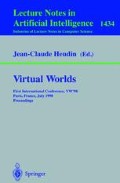Abstract
This paper proposes a solution to the problems associated with network latency within distributed virtual environments. It begins by discussing the advantages and disadvantages of synchronous and asynchronous distributed models, in the areas of user and object representation and user-to-user interaction. By introducing a hybrid solution, which utilises the concept of a causal surface, the advantages of both synchronous and asynchronous models are combined. Object distortion is a characteristic feature of the hybrid system, and this is proposed as a solution which facilitates dynamic real-time user collaboration. The final section covers implementation details, with reference to a prototype system available from the Internet.
Access this chapter
Tax calculation will be finalised at checkout
Purchases are for personal use only
Preview
Unable to display preview. Download preview PDF.
References
Roberts, D. J., Sharkey, P. M.: Maximising Concurrency and Scalability in a Consistent, Causal, Distributed Virtual Reality System, Whilst Minimising the Effect of Network Delays. Proc IEEE 6th Workshops Enabling Tech: Infrastruct. Collab. Enterprises (WETICE’ 97), Boston (Jun. 1997)
Sharkey, P. M., Ryan, M. D., Roberts, D. J.: A Local Perception Filter for Distributed Virtual Environments. Proc IEEE VRAIS’ 98, Atlanta, GA, (Mar. 1998) 242–249
Sharkey, P. M., Roberts, D. J., Sandoz, P. D., Cruse, R.: A Single-user Perception Model for Multi-user Distributed Virtual Environments. Proc. Int. Workshop Collaborative Virtual Environments, Nottingham, UK, (Jun. 1996)
Ryan, M. D., Sharkey, P. M.: Causal Volumes in Distributed Virtual Reality. Proc. IEEE Int. Conf. Syst Man Cybernetics, Orlando, FL (Oct. 1997) 1064–1072
Ellis, F. R., Williams, R. M.: Flat and Curved Space-Times, Clarendon Press, Oxford (1988)
Franklin, G.F., Powell, J.D., Emami-Naeini, A.: Feedback Control of Dynamic Systems. Addison-Wesley (1986)
Broll, W.: Interacting in Distributed Collaborative Virtual Environments. Proc. VRAIS’ 95, North Carolina, (Mar. 1995)
Author information
Authors and Affiliations
Editor information
Editors and Affiliations
Rights and permissions
Copyright information
© 1998 Springer-Verlag Berlin Heidelberg
About this paper
Cite this paper
Ryan, M.D., Sharkey, P.M. (1998). Distortion in Distributed Virtual Environments. In: Heudin, JC. (eds) Virtual Worlds. VW 1998. Lecture Notes in Computer Science(), vol 1434. Springer, Berlin, Heidelberg. https://doi.org/10.1007/3-540-68686-X_4
Download citation
DOI: https://doi.org/10.1007/3-540-68686-X_4
Published:
Publisher Name: Springer, Berlin, Heidelberg
Print ISBN: 978-3-540-64780-5
Online ISBN: 978-3-540-68686-6
eBook Packages: Springer Book Archive

